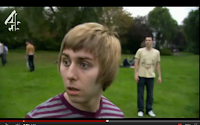This clip has been selected from the TV drama Hotel Babylon. The clip shows various representations of ethnicities, some of which conform to well known stereotypes. I will be analysing and exploring these during this essay.
One of the stereotypes portrayed is shown at the very beginning of the extract, this is the stereotype of the Jamaican man in the pool. The long shot which pans across the setting goes behind the pillars, this emphasises the undesired and unexpected shock of the appearance of the Jamaican/black character. This is reinforced by the reaction shot of the other black character (who is an employee of the hotel), the shocked face and attempt to turn away immediately creates a negative representation of the other character – and therefore also of his ethnicity. The mise-en-scene highlights the contrasting characters in this scene. For example. the large amounts of bold jewellery that the Jamaican character is wearing signifies his bold personality which reinforces the loud, confident, and generally bold ethnic stereotype. This is contrasted by small silver earring that the other black character is wearing, which communicates to the audience that although a part of this stereotype can be applied slightly to him, he has moved on significantly and has moved away from such a lifestyle.
Mise-en-scene is also used to create a provocotive stereotype of the French Maids. The audience imediately knows which maid is more innocent that the other through the colours of their costume, as the maid who refuses to strip is wearing white undwear where as the other is wearing black. White connotates purity and innocence, and black contrasts this as is connotates evilness. The diegetic music within this scene also reinforces the provocative 'French Maid' stereotype, as the music is from Moulan Rouge.
The British characters in this extract are the characters who are shown as superior and in charge, the people who have power within the hotel. They are both blonde, which almost reinforces their superiority because of Hitlers superior 'Aryan Race'. They speak very standard english, in a posh accent, which again reinforces they place in the class system (contrasting the foreign employees). But this typical posh British accent also reinforces the stereotype that Americans often percieve British people to speak like the Queen.
The foreign chef in the scene (who I believe to be Polish, or generally eastern europian) is show to be quite aggressive in his speech actions, which reinforces this aggressive eastern european stereotype. This aggression is magnified by the setting of a kitchen which includes prop's such as knives which could be used as weapons, and also the kitchen is generally percieved to be quite a stressful enviroment, this increases the tension so the audience is constantly feeling on edge waiting for something to happen. Fast cuts and editing emphasise this.
To conclude this scene actively creates and strongly reinforces ethnic stereotypes that the audience are already aware of. This can shape our views of these ethnic groups for ever if the media consistantly reperesents them in this way.
Mise-en-scene is also used to create a provocotive stereotype of the French Maids. The audience imediately knows which maid is more innocent that the other through the colours of their costume, as the maid who refuses to strip is wearing white undwear where as the other is wearing black. White connotates purity and innocence, and black contrasts this as is connotates evilness. The diegetic music within this scene also reinforces the provocative 'French Maid' stereotype, as the music is from Moulan Rouge.
The British characters in this extract are the characters who are shown as superior and in charge, the people who have power within the hotel. They are both blonde, which almost reinforces their superiority because of Hitlers superior 'Aryan Race'. They speak very standard english, in a posh accent, which again reinforces they place in the class system (contrasting the foreign employees). But this typical posh British accent also reinforces the stereotype that Americans often percieve British people to speak like the Queen.
The foreign chef in the scene (who I believe to be Polish, or generally eastern europian) is show to be quite aggressive in his speech actions, which reinforces this aggressive eastern european stereotype. This aggression is magnified by the setting of a kitchen which includes prop's such as knives which could be used as weapons, and also the kitchen is generally percieved to be quite a stressful enviroment, this increases the tension so the audience is constantly feeling on edge waiting for something to happen. Fast cuts and editing emphasise this.
To conclude this scene actively creates and strongly reinforces ethnic stereotypes that the audience are already aware of. This can shape our views of these ethnic groups for ever if the media consistantly reperesents them in this way.









